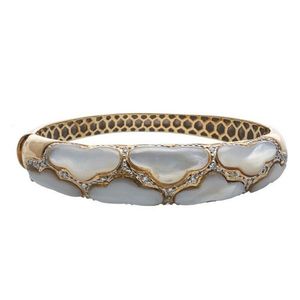Mother of Pearl and Diamond Bangle with Cloud Shapes
A Mother of pearl and diamond snap bangle, featuring seven cloud shaped cabochon mother of pearl pieces, surrounded by forty round brilliant cut diamonds of reported total weight 0.80 carats. 18ct gold. Weight 38.29 grams. Diameter 5.5 cm x 4.80 cm.
You must be a subscriber, and be logged in to view price and dealer details.
Subscribe Now to view actual auction price for this item
When you subscribe, you have the option of setting the currency in which to display prices to $Au, $US, $NZ or Stg.
This item has been sold, and the description, image and price are for reference purposes only.
- Cabochon Cut in Jewellery - A cabochon cut is a type of gemstone cutting where the stone is cut and polished in a convex shape with a flat bottom and a domed top, with no facets. This type of cut is typically used for opaque or translucent stones that have natural patterns or inclusions that are best displayed in this type of cut. Examples of stones that are often cut as cabochons include turquoise, opal, and moonstone.
- Mother-Of-Pearl - Mother-of-pearl, technical name "nacre", is the inner layer of a sea shell. The iridescent colours and strength of this material were widely used in the nineteenth century as an inlay in jewellery, furniture, (especially papier mache furniture) and musical instruments.
In the early 1900s it was used to make pearl buttons. Mother-of-pearl is a soft material that is easily cut or engraved.
Nowadays it is a by-product of the oyster, freshwater pearl mussel and abalone industries. - Brilliant Cut - In their naturally occuring state diamonds have little life or sparkle and for many centuries were simply cut in half and worn in amulets. Invented at the end of the 17th century by a Venetian diamond cutter, a "brilliant cut" diamond has 58 facets arranged in a regular geometric relationship, with 33 above the crown and 25 below on the pavilion.
The introduction of the brilliant cut increased the popularity of diamonds in jewellery as it was the first cut to reveal the fire of the diamond, with the light being internally reflected from one facet to another, and was superior to the previously used table cut and rose cut.Variants to the brilliant cut have emerged since the end of the 17th century, but the popularity of the original brilliant cut has continued to the present time, where it is still the most commonly found cut.
.
This item has been included into following indexes:
- bangles, diamond
- bangles, motif or style - snap bracelets and bangles 120
- bracelets and bangles - mother of pearl 47
